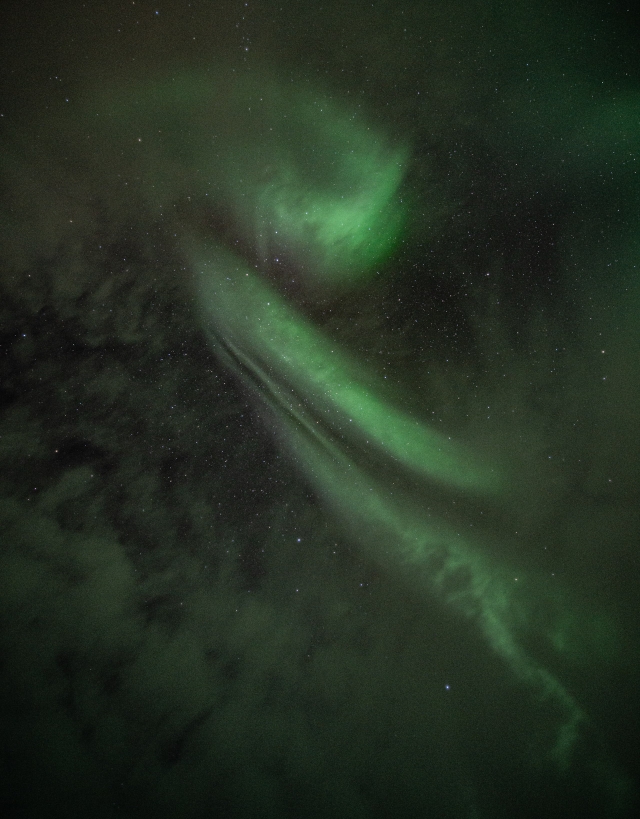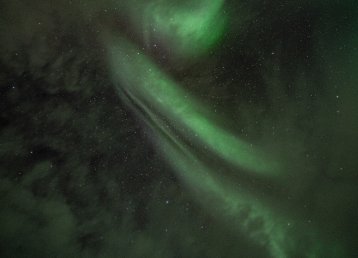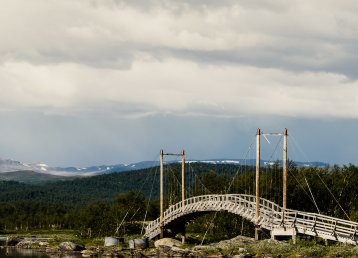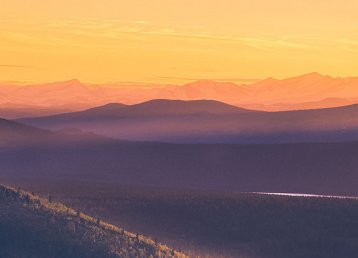1. Location
The famous photographer Sven Hörnell from Riksgränsen, in the Kiruna mountains, once said, when asked if it was expensive to use so much film: “Film is never expensive, it’s the moment that’s expensive”. Sven Hörnell was right, of course. There’s always one photo better than the rest. These days – with quick digital pocket cameras and even great mobile phones – you hardly need to worry about the moment. You just have to be prepared. But when it comes to autumn colours, perhaps it’s a bit different.
– Really, location is everything, says photographer Carl-Johan Utsi when we talk about capturing the colours of autumn. The location that gives you the best depth of field and most colours.
That’s why Carl-Johan often travels around looking for locations. Autumn is the perfect time to go on a road trip to find beautiful colours.
– Another thing to bear in mind when capturing the autumn colours of the landscape is trying to get up high. It gives images a greater depth.
2. Light
Of course, light is always important in a picture. In many ways, light gives the image life. But don’t think you need sunshine all the time. On the contrary, sunny days can be a bit restrictive as the best light – the so-called trailing light – only occurs in the morning and the evening.
– I’ve taken many of my best autumn pictures in fog and cloudy weather, says Carl-Johan. A cloudy day also gives you a chance to drive around all day and work with new scenery. You don’t have to wait for the evening or morning light.
– But if you have bright sunlight during the day, try to experiment with the camera settings to capture a good backlight – that is, shooting towards the sun instead of away from it.
– Details in backlight can look really good. The sun shining through a beautifully coloured leaf or a deciduous forest gives great colours and drama.
Wildlife photographer Magnus Winbjörk
Wildlife Photographer Magnus Winbjörk capture arctic elements and wildlife in the very North of Sweden. Above the Arctic circle he spend most of his time in the outdoors striving to share his view on the arctic elements.
3. Camera equipment
Perhaps the most important detail for landscape photography in autumn is the tripod. But if you haven’t got a tripod and need to hold the camera steady yourself, it’s better to change the ISO setting than opening the aperture to match the shutter time.
An old rule is for the shutter speed to match the size of the lens. A 100 mm lens requires a shutter speed of at least a hundredth for blur-free images. A 200 mm lens requires a shutter speed of at least 1/200 and a 400 mm perhaps 1/500 of a second, and so on. To get the greatest possible depth of field, you have to shoot with the aperture as open as possible, perhaps f16. On a cloudy day, if you use an aperture of f16 with a 200 mm lens, you will probably have to increase the ISO to be able to take sharp pictures.
"Light is always important in a picture – in many ways, light gives the image life"
But if you are using a tripod you hardly have to worry about the shutter speed – unless you’re in the middle of a storm, that is. With a tripod, you can basically just concentrate on the picture you want to achieve with the aperture you’ve chosen, not worrying about the speed. Carl-Johan takes many of his autumn pictures with zoom lenses.
– In autumn, I like ‘squishing’ the landscape to increase the colour intensity of the picture instead of just letting the landscape spread out through a wide-angle lens. If you know what I mean?
4. Water
Don’t be scared of water when you’re taking pictures of autumn. A lake can provide you with amazing mirror images of a lone birch or aspen in an evergreen forest, for example. Look for reflections; it always increases the effect of the amount of colour in the landscape.
Running water is also easy since the sun isn’t as strong in autumn and you can use relatively slow shutter speeds to give water that running/moving effect on the photos. A tripod is a big advantage for these kinds of shots as well.
But if you haven’t got a tripod, you can get sharp images with water movement using a shutter speed of 1/15 and a wide-angle lens that is 24 mm or ‘shorter’. For slower speeds, you need a tripod. Also, keep in mind that near water and large lakes there’s often fog and mist. It always gives your autumn photos a bit of extra life and mystery.
The adventure photographer
Mattias Fredriksson is one of the most published photographers in the outdoor world. In this film he returns to Riksgränsen, a ski resort in the north of Sweden, where it all started.
5. Explore
Like we said earlier, autumn is a perfect time to drive around Swedish Lapland and explore your favourite scenes. The atmosphere on roads and paths is quieter. You don’t have to get up at two o’clock in the morning to capture the sunrise. Autumn is, in many ways the perfect time to explore your inner photographer. What is it you want to capture, and why?
"Autumn is a good time to be a photographer; it's as simple as that"
You can sit by the evening fire in Saltoluokta and read up on some photo tips in the book you bought and try the result the next day. Autumn is a good time to be a photographer; it’s as simple as that. The sunrise is more intense, the trailing light lasts a bit longer and in the evening, after a magical sunset, perhaps you’ll see the first northern light of the year. Also, explore opportunities to vary your pictures.
Take close-ups of autumn leaves on the ground, or floating on a lake, or lingonberries showing traces of the first frost. Among small streams and waterfalls in the forest, you can use a wide-angle lens since the subjects cover the whole image. But you can also bring out details and light phenomena with a telephoto lens. For example, the reflected image of a moss-clad stone in a lake painted in the colours of autumn.
Catching all the different colour combinations is part of autumn as well, of course. Colourful trees rising like magical creations backlit against a blue sky. We’ve already talked about reflections. Once you’ve captured the perfect reflection, it might be time to try something more ‘abstract’. Take the same photo with a motion blur, letting the colours flow into each other. Make sure you really make the most of your time now that you’ve got autumn and the landscape to yourself. That way your photos will be a bit more interesting, and you’ll get a bit better as a photographer.
Nature photography in the Arctic
The good friends Konsta Punkka, Tobias Hägg and Magnus Winbjörk are all renowned photographers within nature and wildlife photography. Their friendship builds upon the lowest common denominator — a genuine passion for the moments, the craft and the outdoors.































